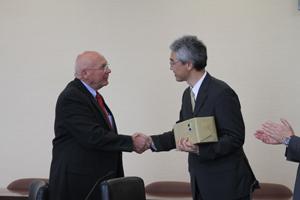History repeats itself. The U.S. Grains Council and National Corn Growers Association officers find parallel trends between mature and developing markets.
The influence of the Council’s programs was apparent in the two long-standing, loyal U.S. markets of Japan and Korea, according to USCG chairman Don Fast, with all signs pointing to the same future success in the emerging market of China. Fast was speaking from China, where he was leading the 2013 Officers Mission.
“The impact of the Council’s programs over the last 50 years in South Korea and Japan were particularly evidenced by the growth, the maturation, and technical exchanges that have led to the establishment of modern livestock and starch producing industries,” said Fast. “In China, we are just in the middle of that whole process.”
China’s agricultural sector is a fundamental and strategic structure of China’s economy. China is an agricultural powerhouse: the world’s leading producer of wheat, rice, pork, potatoes, seafood, vegetables and cotton; the second leading producer of corn, and poultry; and the third leading producer of beef, citrus, sugar, and milk. The livestock sector accounts for 32 percent of China’s agriculture GDP and has significant growth potential as China’s continuing rapid economic and social development drives consumer demand for enhanced diets. This sector continues to be a long term export opportunity for U.S. feed grains.
The Council has been active in China for more than 30 years, collaborating with industry and government counter parts. According to China’s Ministry of Agriculture, these exchanges play an important role and contribution to overall development in China.
Sustaining customer loyalty and upholding international dialog is an important venture for the Council to continue, said NCGA President Pam Johnson, who participated in the mission.
“We are faced with a completely new global supply and demand situation. The short U.S. corn crop spurred reaction from our most valued customers to diversify their grain import portfolio. Now is the time for the U.S. farmer to reassure our trade partners that we are a reliable supplier and that their demands are a top priority,” she said.
Food security was a consistent theme in all three countries both in terms of a higher level of production sufficiency and through international trade. While all are trying to avoid trade interruptions, like embargos, the drought in the United States certainly impacted the images of what it means to be food secure.
“It’s time to reinvent ourselves in terms of how we can expand the dialog with end-users, policy officials and academia that are all talking about issues such as biotechnology, food security and food supply,” said Tom Sleight, USGC president and CEO.
“In Japan particularly we can talk about the realities of the TPP (Trans-Pacific Partnership), look at the innovations it will demand from the marketplace and help change together as we have for the last 50 years. We have a foundation of understanding in Japan, and we need to have that conversation be more encouraging and positive rather than politically divisive.”
Change is imminent. New market demands in South Korea and Japan and the explosive demand in China will require adjustment and innovation to keep the United States prominent in the marketplace.
While there are still things we have to go through to realize that demand, Sleight said “staying engaged through our country offices, country directors – that’s what is making a difference for U.S. coarse grains in these markets.”


